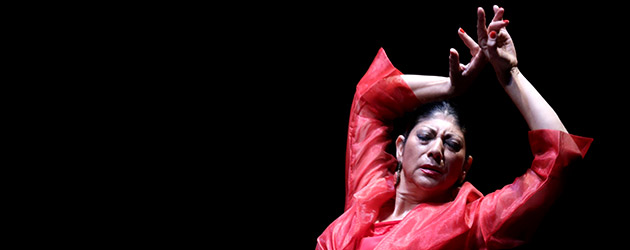Text: Estela Zatania
Photos: Rafael Manjavacas
18th Bienal de Flamenco de Sevilla
Sunday, September 21st, 2014. 830pm. Teatro de la Maestranza
THE AROMA OF CINNAMON
Dance: Manuela Carrasco. Corps de ballet: Saray de los Reyes, Lole de los Reyes, La Marquesita. Cante: Enrique «El Extremeño», Pepe de Pura, Zamara Carrasco, Mara Rey. Guitar: Paco Jarana, Juan Campallo, Manuel de la Luz. Percussion: José Carrasco. Palmas: El Choro, Jesús Corbacho. Guest artists: Miguel Poveda, Diego Amador.
Dancer Manuela Carrasco was the star of Sunday's program at the Bienal de Flamenco de Sevilla. Cult figure, beautiful in her maturity, power, a stately Andalusian woman and portrait of the most racial sort of flamenco…few followers of this art-form fail to have a special place in their hearts for this grand dame who continues to deliver a kind of flamenco that sometimes seems more like a dream than anything else. At this point in time we also naturally appreciate the young avant-garde artists with their surprising creations, but as Luis de la Pica used to sing: «Manuela, Manuela, Manuela, cuando escucho tu nombre, la boca me sabe a canela», («Manuela, Manuela, Manuela, when I hear your name, my mouth tastes of cinnamon»)
Racism in flamenco has become unfashionable, but the associated romanticism is hard to divorce from the nature of this genre which is famous for triggering intense emotion, a sense of freedom and authenticity as none other. The dancing of Manuela Carrasco promises all that, and more. She is also the epitome of female dignity, and elegance without excess.
On this occasion she benefitted from the expert counseling of Juana Casado, director and stage manager, which added a touch of order and sophistication without subtracting spontaneity. Another novelty was the inclusion of a corps de ballet of three young women dancers. But most noteworthy were the guest artists, Diego Amador on piano and vocals, reviving Camarón's «Canastera», danced by Manuela, and the wildly popular Miguel Poveda, whose appearance on stage triggered one of the most emotional ovations of the night. Amador also accompanied himself on piano for some fandangos naturales, even one of Niño Gloria that came out well. His voice and piano, with the guitars of Paco Jarana, Juan Campallo and Manuel de la Luz joined forces por soleá
The three young women dancers interpreted alegrías with a refreshing choreography that avoided the chorus-line effect by allowing for intentional differences in the steps each one did.
Poveda sang tientos tangos moving freely around the stage rather than seated before a mike, something which gave a great deal of life and interest. For some, his collaboration with Manuela seemed odd, but the language of flamenco put them on the same wave length, and it was magical. «Se parece la la Giralda» sang Miguel to the dancer when she raised her majestic arms. With Manuela's power, and the Catalonian singer's communicative power, the charisma of each joined forces and multiplied, making for some frankly unforgettable moments. It's unfortunate the great veteran singer Enrique el Extremeño, relegated to doing palmas for the soleá, was not permitted a couple of verses in honor of the thirty years he's been singing to Manuela for this most representative dance of hers.
At eleven o'clock at the Teatro Central, Belén Maya presented her award-winning show «Los Invitados», with the noteworthy collaboration of Manuel Liñán.
